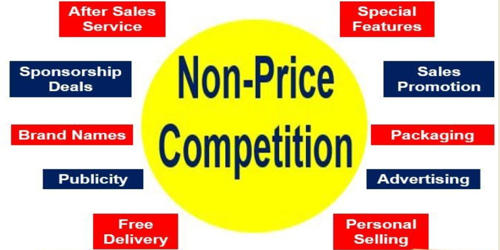Non-price competition is a form of competition in which two or more producers use such factors as packaging, delivery, or customer service rather than price to increase demand for their products. It is a marketing strategy “in which one firm tries to distinguish its product or service from competing products on the basis of attributes like design and workmanship”. It involves firms distinguishing their products from competing products on the basis of attributes other than price. The firm can also distinguish its product offering through the quality of service, extensive distribution, customer focus, or any sustainable competitive advantage other than price. It can be contrasted with price competition, which is where a company tries to distinguish its product or service from competing products on the basis of a low price. It can be contrasted with price competition, which is where a company tries to distinguish its product or service from competing products on the basis of low price.
The non-price competition typically involves promotional expenditures (such as advertising, selling staff, the location’s convenience, sales promotions, coupons, special orders, or free gifts), marketing research, new product development, and brand management costs. It contrasts with price competition, in which rivals try to gain market share by reducing their prices. Firms will engage in non-price competition, in spite of the additional costs involved, because it is usually more profitable than selling for a lower price, and avoids the risk of a price war. It is often adopted by the competing players in a sector in order to prevent a price war, which can lead to a damaging spiral of price cuts.
Non-price Competition is a marketing strategy that typically includes promotional expenditures such as sales staff, sales promotions, special orders, free gifts, coupons, and advertising. Although any company can use a non-price competition strategy, it is most common among oligopolies and monopolistic competition, because firms can be extremely competitive. Most companies across the world are involved in either non-price competition, price competition, or both. Businesses can also decide to compete against each other in the form of non-price competition such as advertising and product development. It can include the quality of the product, unique selling point, superior location, and after-sales service. The oligopolistic business normally do not engage in price competition as this usually leads to a decrease in the profit businesses can make in that specific market. The majority of industries are a form of oligopoly with a few firms dominating the market.
The non-price competition involves advertising and marketing strategies to increase consumer demand and develop brand loyalty. It is a key strategy in a growing number of marketplaces (oDesk, TaskRabbit, Fiverr, Airbnb, mechanical Turk, etc) whose sellers offer their Service as a product, and where the price differences are virtually negligible when compared to other sellers of similar productized services on the same market places.
Advantages –
- Better sales tactics,
- Improved product quality,
- Different presentations of products for varied demographics.
Disadvantage:
The main drawback is that consumers are not likely to notice the changes straight away – which is not the case when prices are lowered.
















